If you’re a bird watcher, you know that Massachusetts is home to some pretty incredible geese. We take a look at the different types of geese that can be found in the state, as well as some of the best places to see them.
What Geese Are in Massachusetts?
There are four goose species and two swan species living in the state of Massachusetts.
- Canada Goose
- Snow Goose
- Cackling Goose
- Brant
Swans living in Massachusetts include Tundra Swan and Mute Swan.
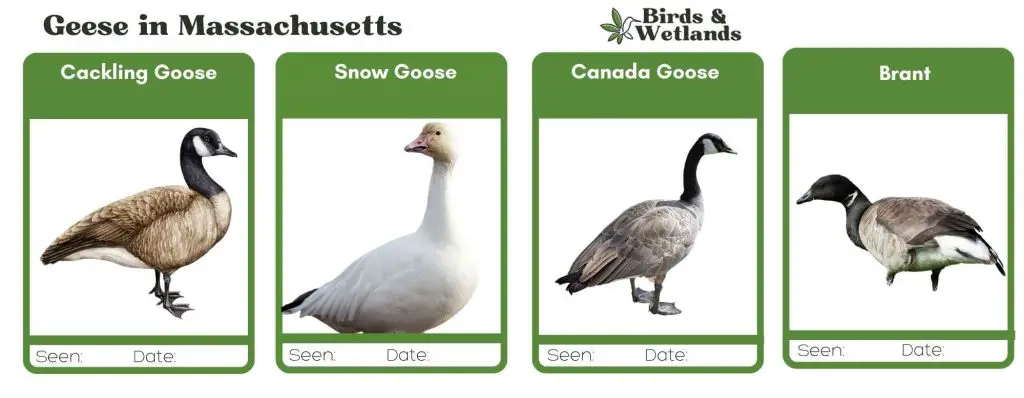
Canada Goose
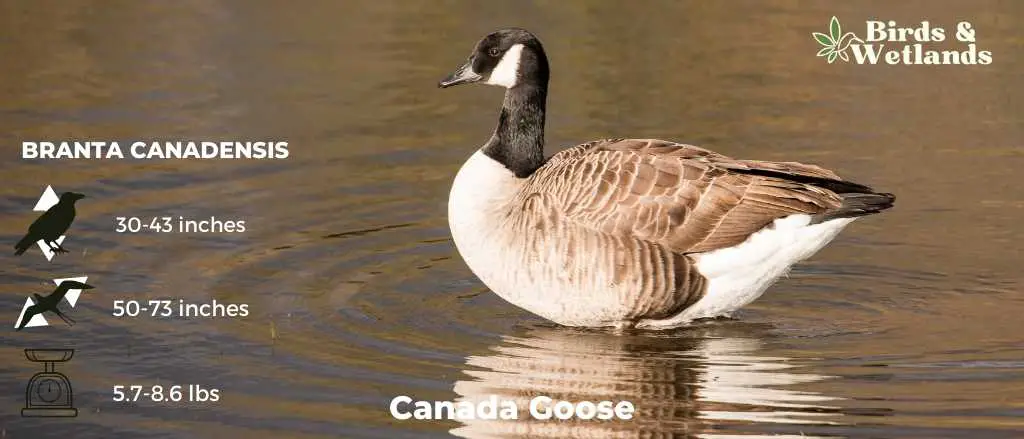
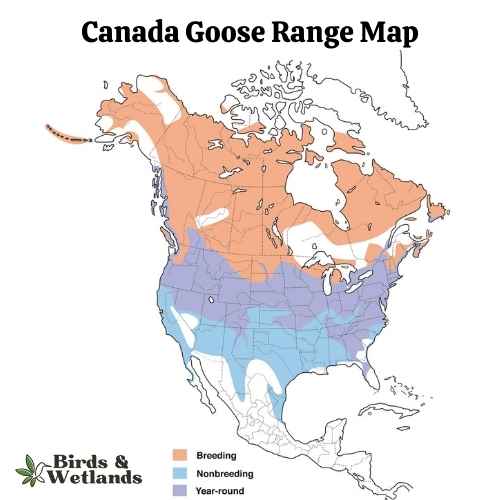
Canada Goose Sound
Scientific Name: Branta canadensis
Length: 30 to 43 in
Wingspan: 50–73 in
Weight: 5.7–14.3 lb
The Canada Goose is a large, well-known species of waterfowl noted for its distinctive appearance, familiar “honk,” and migratory behavior.
Appearance: Both male and female Canada Geese have a similar appearance, featuring a black head and neck with distinctive white patches on the cheeks and chin. The body is primarily brown with a lighter, often white, underbelly.
Diet: Canada Geese primarily feed on plant matter, including grasses, aquatic vegetation, and grains. They can often be seen grazing in parks, lawns, and fields, as well as dabbling in water bodies.
Reproduction: Canada Geese typically nest on the ground near water bodies, often on islands or other isolated areas to avoid predators. The female lays a clutch of about 4 to 6 eggs, which she incubates alone for around a month.
Snow Goose
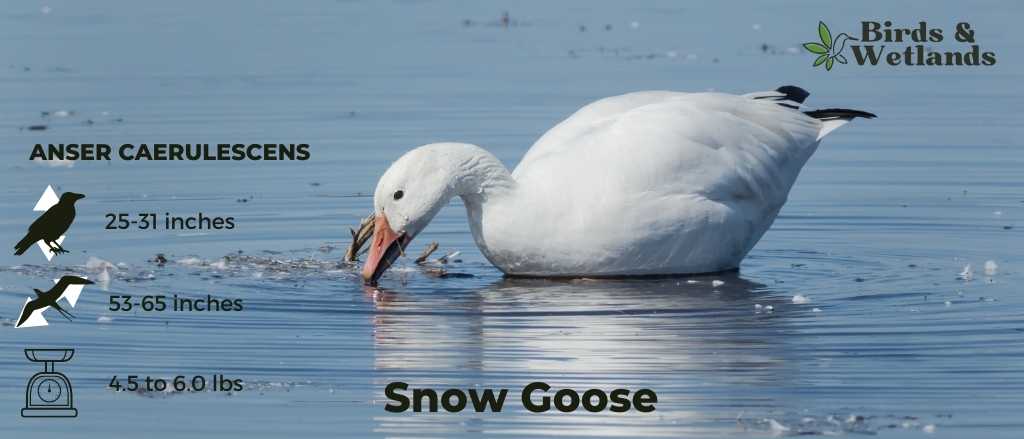
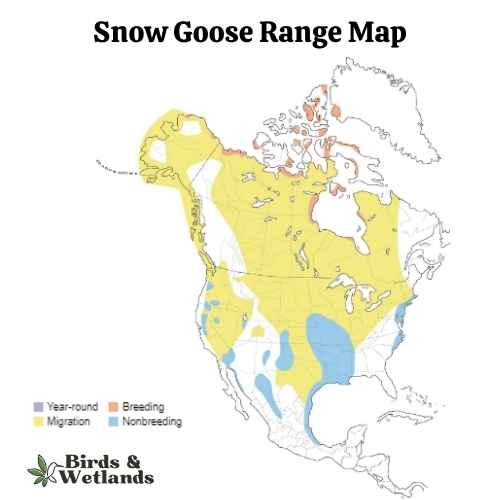
Snow Goose Sound
Scientific Name: Anser caerulescens
Length: 25 to 31 in
Wingspan: 53 to 65 in
Weight: 4.5 to 6.0
The Snow Goose is a large species of waterfowl known for its vibrant white plumage and significant migratory flights.
Appearance: True to their name, Snow Geese are predominantly white with black wingtips. They also have a pink bill, pink legs and feet. A color morph, known as the “Blue Goose,” displays a bluish-gray body with a white head, but is considered the same species.
Diet: Snow Geese primarily feed on plant matter, such as grasses, sedges, and small grains. They can often be seen in large flocks foraging in fields and marshes, and during migration and winter, they can cause considerable damage to agricultural fields due to their feeding habits.
Reproduction: Snow Geese typically nest on the tundra, near water bodies. The female builds the nest and lays a clutch of about 3 to 5 eggs, which she incubates alone for approximately three weeks. Once hatched, the goslings can feed themselves but stay with their parents for protection until they can fly.
Cackling Goose
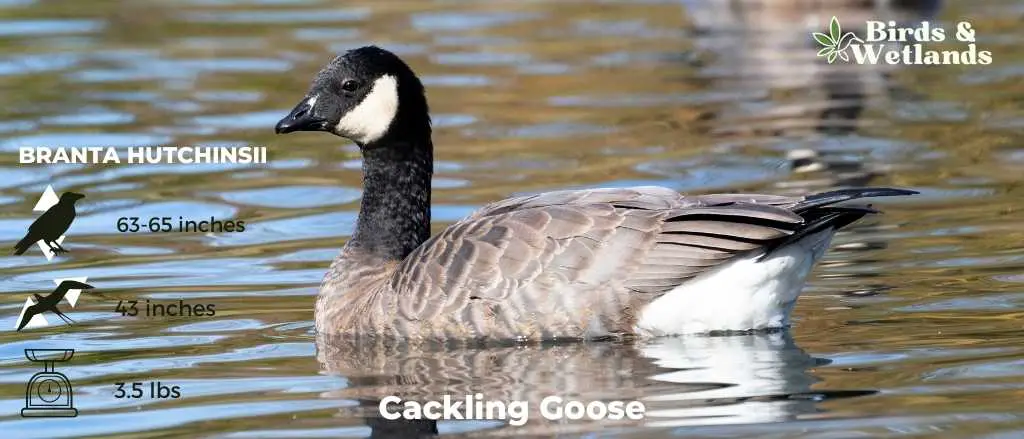
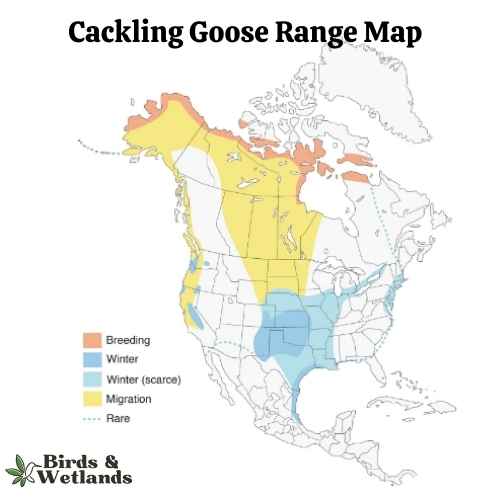
Listen
Scientific Name: Branta hutchinsii
Length: 24.8–25.6 in
Wingspan: 43-45.7 in
Weight:3.5 lbs
Cackling Geese are particularly known for their high-pitched, cackling calls, which is the source of their name. Despite their small size, these geese are renowned long-distance migrants, with some populations traveling thousands of miles between breeding and wintering grounds.
Appearance: With a similar color pattern to the larger Canada Goose, the Cackling Goose features a black head and neck, white chinstrap, light tan to cream chest, and brownish-grey body. One defining characteristic is its noticeably smaller size and stubbier neck compared to its larger counterparts.
Diet: Like many geese, the Cackling Goose’s diet mainly consists of plant matter. This includes grasses, seeds, and aquatic vegetation. They are often seen grazing on land or dabbling in shallow water.
Reproduction: Cackling Geese usually nest on the ground in elevated areas near water bodies, such as riverbanks or lakeshores. The female lays a clutch of 2 to 8 eggs and is responsible for incubation, while the male stands guard nearby. Incubation lasts for about a month.
Brant
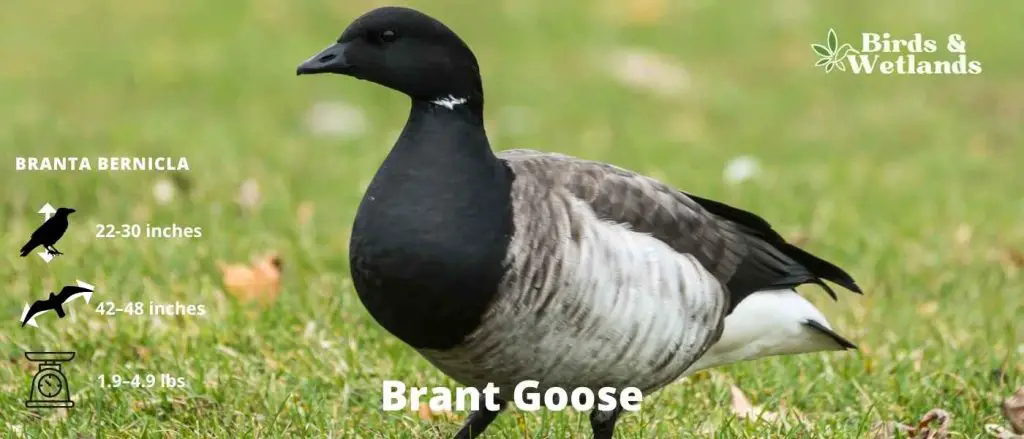
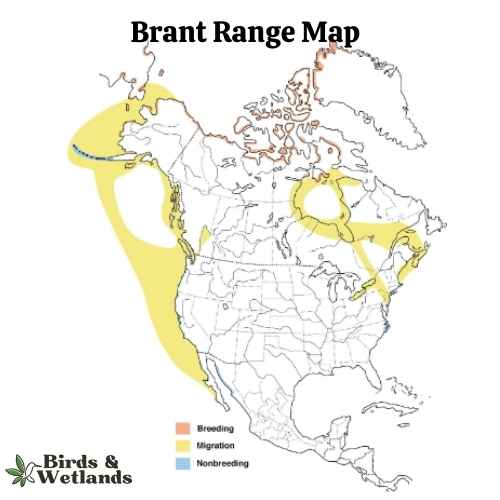
Listen
Scientific Name: Branta bernicla
Length: 22–26 in
Wingspan: 42–48 in
Weight: 1.9–4.9 lb
The Brant is a compact species of goose that is known for its striking appearance and interesting migratory patterns.
Appearance: The Brant is recognized for its dark, sooty color with a white crescent on the neck. The body is mostly black to dark gray, contrasting with the lighter underparts. Its small size, as compared to other geese, and short, stubby bill are other distinct features.
Diet: The Brant’s diet primarily consists of aquatic plants, especially eelgrass and sea lettuce. During the breeding season, they may also feed on grasses, sedges, and insects.
Reproduction: Brants typically breed in the high Arctic tundra. The female lays a clutch of 3 to 5 eggs in a ground nest, which she incubates for about a month.
Notably, Brants make an impressive long-distance migration every year. They spend their winters along both the east and west coasts of the United States and travel to the Arctic regions of Canada, Alaska, and even Russia to breed.
Are There Any Resident Flocks of Geese in Massachusetts?
There are indeed resident flocks of geese in the state. However, these flocks are much smaller than the migrating populations that pass through in the spring and fall.
The most common goose species found in Massachusetts is the Canada goose, which can be seen in both urban and rural areas.
Hunting Geese in Massachusetts
In order to hunt geese in Massachusetts, you need to purchase a state waterfowl stamp and register with the Harvest Information Program (HIP).
ou can register for HIP by taking the HIP survey. The state waterfowl stamp will automatically register you for HIP.
Can You Shoot a Goose in Massachusetts?
Yes, you can shoot geese in Massachusetts, but there are some restrictions in place.
For example, you can only use a shotgun no larger than 10 gauge and it must be fired from the shoulder.
Additionally, shotguns that are capable of holding more than 3 shells must be plugged with a one-piece filler that limits the gun’s total capacity to 3 shells. This filler cannot be removed without disassembling the gun.
Finally, waterfowl hunters must use non-toxic shots while hunting ducks, geese, sea ducks, and coot. Lead shot is not allowed while hunting these birds.
Here’s Massachusetts’s daily bag and possession limits on geese:
Regular Goose (except Snow & Blue)
| Dates | Daily Bag | Possession | |
| Berkshire | Oct. 10 – Nov. 12 | 1 | 3 |
| Central | Oct. 10 – Nov. 26 Dec. 27 – Jan. 16 | 2 | 6 |
| Coastal | Oct. 15 – Oct. 22 Dec. 1 – Jan. 31 | 2 | 6 |
Early Canada Goose (Statewide)
| Dates | Daily Bag | Possession |
| Sep. 2 – Sep. 24 | 15 | 45 |
Late Canada Goose
| Dates | Daily Bag | Possession | |
| Berkshire | Dec. 15 – Feb. 15 | 5 | 15 |
| Central | Jan. 18 – Feb. 15 | 5 | 15 |
| Northern portion of Coastal Zone | Feb. 1 – Feb. 15 | 5 | 15 |
Snow & Blue Goose
| Dates | Daily Bag | Possession | |
| Berkshire | Oct. 10 – Nov. 26 Dec. 19 – Jan. 7 | 15 | 45 |
| Central | Oct. 10 – Nov. 26 Dec. 27 – Jan. 16 | 15 | 45 |
| Coastal | Oct. 15 – Oct. 22 Dec. 1 – Jan. 31 | 15 | 45 |
Where Can I Hunt Geese in Massachusetts?
Waterfowl hunting grounds in Massachusetts are divided into three hunting zones – Berkshire, Central and Coastal. You can check the map of waterfowl zones in Massachusetts here.
Conclusion on Geese in Massachusetts
If you’re ever in Massachusetts and you want to see some amazing wildlife, be sure to keep your eyes peeled for geese and swans! There’s a good chance you’ll see at least one of these beautiful creatures.


